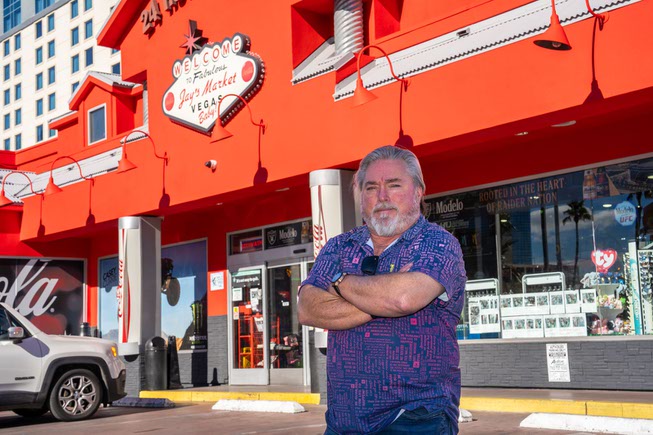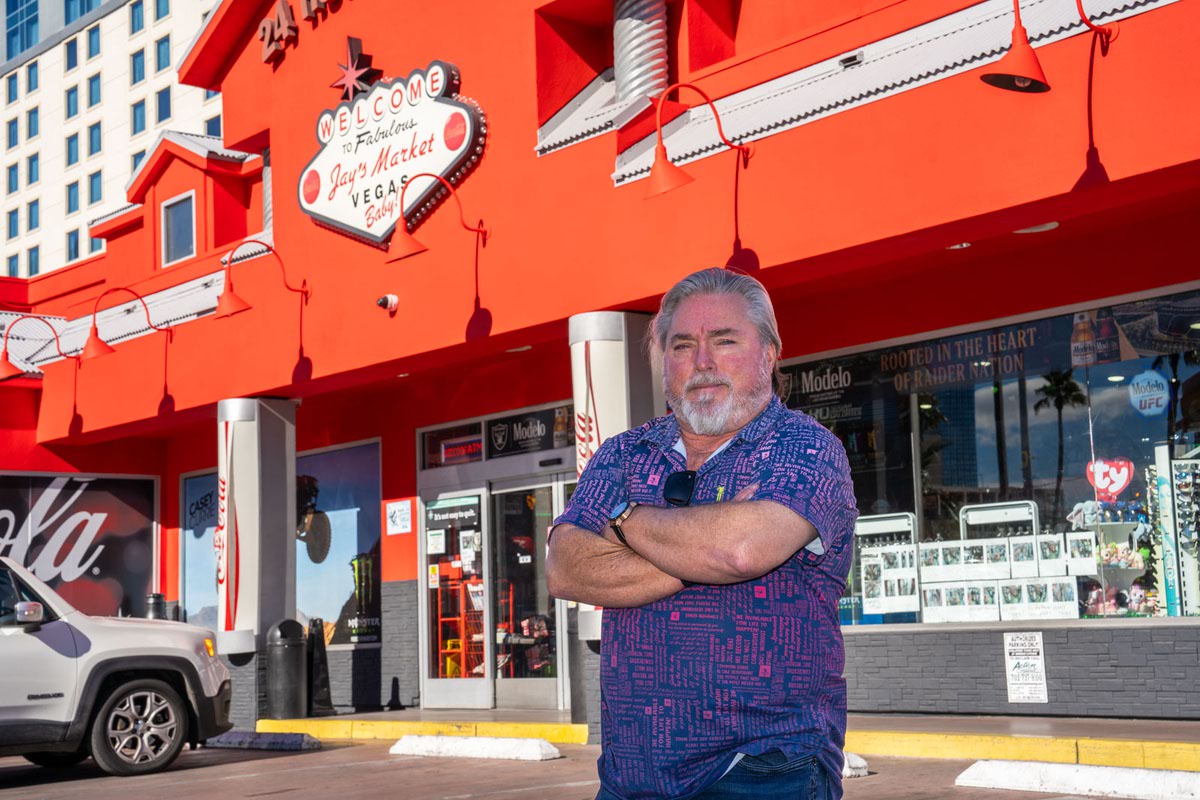
Brian Ramos
Wade Bohn, owner of Jay’s Market on Flamingo Road, stands under the temporary bridge that was constructed in front of his business at the corner of Koval Lane and Flamingo as part of remaking the Resort Corridor for the Formula One race in November.
Tuesday, March 19, 2024 | 8:55 p.m.
The Las Vegas Grand Prix experience for Eileen Scott, a Las Vegas Strip cocktail waitress, can best be represented by her wait time for the Las Vegas Monorail.
To get the thousands of Strip workers to their jobs on Las Vegas Boulevard during last year’s inaugural Formula One race, officials relied on the monorail that runs a 3.9-mile route from the Sahara to MGM Grand.
What was supposed to be operating at constant four- to eight-minute intervals became a longer wait as tourists and Strip workers battled for space in the monorail cars, she said. Scott said she had to wait for the monorail to come around two or three times before finally being able to step on.
“Everyone was so excited about this important event — like, F1 in our city. And one of the things that the residents and the workers in Las Vegas heard a lot about last year was that this event was going to bring so much money to our economy and to our city,” Scott said.
“I’m hoping that the city and F1 come up with a better solution this year for the workers of Las Vegas. F1 claimed that it was a success, but for the residents and the workers, it was not.”
The Clark County Commission on Tuesday requested Formula One organizers present a transportation plan by May 1 to commissioners for the race in November detailing how to get workers and race fans to the Strip in a timely manner.
“Transportation has to come first, and we have to talk to the public,” Commissioner Marilyn Kirkpatrick said. “Transportation, first and foremost, because we ought to know how to move people around; it’s a master transportation problem and it should be the first thing for every high-impact event that we do because we gotta know how to move people around, regardless.”
The Las Vegas Grand Prix amassed the largest global audience and became the largest sporting event in Las Vegas history, said County Manager Kevin Schiller in a report given to commissioners on Tuesday. Harry Reid International Airport also rose to the second busiest airport in the United States during race week.
The total economic impact was $884 million, and about $77 million was generated in tax revenues for state and local government, which Schiller says is more than any event in Las Vegas history.
Of the roughly $77 million, Clark County received 5.7%, or $4,387,597 that supported services like the county’s general fund and fire service district. The other 32.5% went towards local agencies such as the Las Vegas Convention and Visitors Authority, Regional Transportation Commission, Regional Flood Control District and Stadium Authority Board.
But the event still had significant challenges across various departments that were involved, Schiller explained during the presentation.
The Department of Aviation, Building Department, Business License Department, Clark County Office of Emergency Management, Clark County Fire Department and Clark County Public Works all reported difficulties in operating during the Las Vegas Grand Prix. Metro and the Regional Transportation Commission, who were considered regional partners, also conducted their own reviews of their involvement in last year’s race.
Issues in all of these reports ranged from construction beginning before necessary permits were issued for the Pit Building off Koval Lane to spilled sewage from portable restrooms to a lack of consistent representatives from the race.
Schiller also said there were many “last-minute changes” made in what was considered the “final hour” of race preparations, which was said to have stressed out county employees in multiple areas of the county’s report.
“If you take this event in coordination with Super Bowl and you take in coordination with New Year’s and all of those pieces — which were full-time events, there’s always something that is coming — there’s the impact to the constituents, there’s the impact to the projects,” Schiller said during his presentation, noting that county employees alone spent over 17,000 hours helping prepare for the race.
“And then directly to them the issue of when they’re trying to catch up related to those events is very difficult to establish a catch-up time, right? So, you have morale, you have exhaustion, you have those pieces,” he continued.
Local business owners with spots along the 3.8-mile racetrack have voiced their frustration with the race for months, revealing that many of them lost millions in revenue or shut down altogether due to the construction and road closures.
During public comment on Tuesday morning, many of them showed up to urge the county to help them get compensation from Formula One for their losses.
Lisa Mayo-DeRiso, who represents a group of businesses planning to sue Formula One, said the race didn’t positively impact the economy and impeded the right of citizens to access certain businesses.
“We cannot sacrifice the lifeblood of our economy — the famed Las Vegas Strip — on the altar of F1,” said Randy Markin, who owns three businesses — Battista’s Hole in the Wall, Stage Door Casino and Liquor Mart — on the race course route. “Stand with the small business owners, the mom and pops, the hourly workers. Let F1 know that we are driving this car, and you have listened to our voices, and that our town is not for sale.”
In addition to that transportation plan, the commission also urged race officials to consider more community engagement, compliance with Southern Nevada Health District food regulations, improving credentialing and access during race weekends and making the specific recommendations laid out by Public Works among other suggestions.

